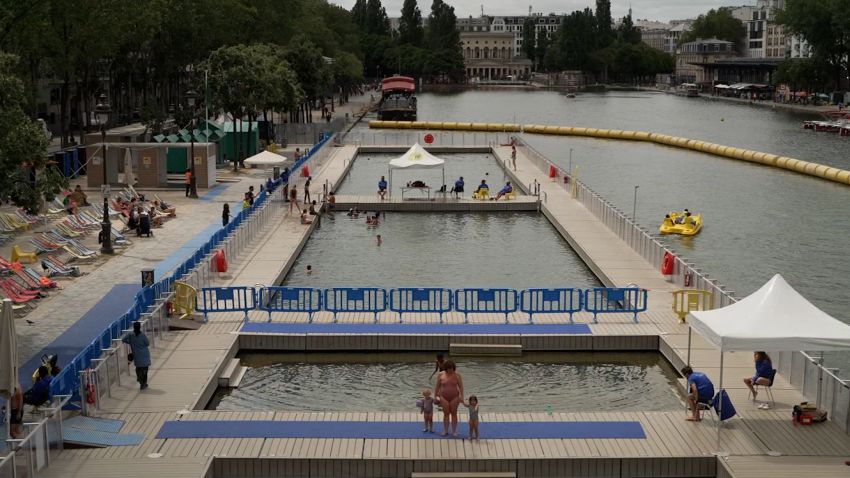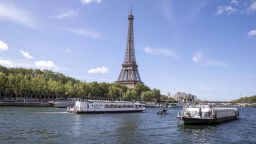Editor’s Note: David A. Andelman, a contributor to CNN, twice winner of the Deadline Club Award, is a chevalier of the French Legion of Honor, author of “A Red Line in the Sand: Diplomacy, Strategy, and the History of Wars That Might Still Happen” and blogs at Andelman Unleashed. He formerly was a foreign correspondent for The New York Times and CBS News. The views expressed in this commentary are his own. View more opinion at CNN.
Back in the 1980s, when I first began living in Paris, I once had to clamber onto the tiny exterior staircase that surrounds the Eiffel Tower and is used to paint or repair it.

There, hanging out over the city some thousand feet up, I filmed my on-camera segment for CBS about engineering work on the tower. A nightmare assignment for a journalist with acrophobia.
Still, at that time, nothing could have impelled me to risk a swim in that other iconic Parisian sight — the Seine River — not without a full biohazard suit.
And nothing now could get me into the river that has all the romance of One Thousand and One Nights as it winds its magical eight miles through Paris and off into the countryside.
The leaders of the city of Paris want to persuade me otherwise. It seems the 2024 Paris Olympics organizers want to make this fabled river the centerpiece of the lavish opening ceremony a year from now and for the entire 17 days of the games.
In short, they want to clean up the Seine for swimming events. Good luck.
“I wouldn’t swim in that water at gunpoint,” said Mort Rosenblum, the former editor of the International Herald Tribune, who’s owned a houseboat barge, tied up to the north bank of the Seine just east of the Pont de la Concorde, for at least four decades.
But, he admitted to me, his pet cat’s fallen in the river a dozen times and survived. Of course, he’s never dived in to fish her out.
Indeed, swimming has been banned from the river since 1923 due to pollution. With commercial barge traffic, tour boats, the fabled bateaux mouches dinner cruises, not to mention the raw sewage that, in the past, was dumped untreated, it’s hard to see how any living organism could survive. Some have. There have been some extremely large catfish hauled out of the water, one at least eight feet long.
But as Mort continued, “I’m not eating any Seine River sushi.”
In 1988, Jacques Chirac, the then-mayor of Paris, later France’s president, released 5,000 pike into the river, throwing out a challenge of his own: he’d make the Seine so clean that by 1992 he’d be prepared to swim across it himself.
“I will come with bath towels and antibiotics,” Brice Lalonde, then-French Minister of the Environment shot back.
Today’s Mayor of Paris, Anne Hidalgo, has made a similar promise, and local authorities have put 1.4 billion euros ($1.55 billion) behind it. Paris has indeed made strides in cleaning up its famous river — water samples from June showed “excellent results” in complying with European regulation, according to city hall.
Disinfection units at wastewater treatment plants and a rainwater storage basin are en route. (Mort says he’ll have to install a waste capture tank on his houseboat.)
Promising three permanent bathing sites on the Seine by 2025, Hidalgo boasted earlier this month, “Promise kept, we swim in the Seine, and this is only the beginning, it is thanks to the adventure of the Olympic and Paralympic Games that we were able to have a swimmable, clean Seine.”
“Its quality has been improving year by year and will improve further by next year,” added Hidalgo.
This is, incidentally, the same mayor who thought cohabitation might be an appropriate way of dealing with the capital’s rat infestation.
Of course, like Chirac before her, Hidalgo herself doesn’t appear to have actually taken the plunge. Instead, she sent her first deputy, Emmanuel Grégoire, and her deputy for sports, Pierre Rabadan, to swim with a few other “licensed swimmers” in a narrow area specially cleansed for the occasion called “Paris plage” (beach) across from the Île Saint-Louis.
The river, its bridges and quays have been the backdrop for plenty of romantic films and thrillers over the generations. In “Charade,” a 1963 film starring Audrey Hepburn and Cary Grant, the stars stroll along the Quai de Montebello — and talk about following in the footsteps of Leslie Caron and Gene Kelly, who danced along this same stretch a decade earlier in “An American in Paris” (1951).
In 1972’s “Last Tango in Paris,” Marlon Brando and Maria Schneider first meet on a Seine bridge.
And in 1985, Roger Moore’s James Bond leaps onto a passing boat in “A View to a Kill.” Decades later, in 2008, Liam Neeson also jumps off a bridge in pursuit of his daughter’s kidnappers at the end of “Taken.”
Taking the Parisian landmarks to another level, in 2007’s “Rush Hour 3,” Chris Tucker and Jackie Chan escape the Eiffel Tower by grabbing a huge French flag, parachuting gracefully across the Seine and into a fountain on the other side.
But take special note. No one swims, leaps or dives into the Seine in any of these encounters. Most prudent.

